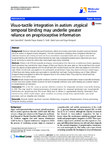Visuo-tactile integration in autism: atypical temporal binding may underlie greater reliance on proprioceptive information
| dc.contributor.author | Greenfield, K | |
| dc.contributor.author | Ropar, D | |
| dc.contributor.author | Smith, Alastair | |
| dc.contributor.author | Carey, M | |
| dc.contributor.author | Newport, R | |
| dc.date.accessioned | 2019-07-16T12:44:25Z | |
| dc.date.available | 2019-07-16T12:44:25Z | |
| dc.date.issued | 2015-12 | |
| dc.identifier.issn | 2040-2392 | |
| dc.identifier.issn | 2040-2392 | |
| dc.identifier.other | 51 | |
| dc.identifier.uri | http://hdl.handle.net/10026.1/14648 | |
| dc.description.abstract |
BACKGROUND: Evidence indicates that social functioning deficits and sensory sensitivities in autism spectrum disorder (ASD) are related to atypical sensory integration. The exact mechanisms underlying these integration difficulties are unknown; however, two leading accounts are (1) an over-reliance on proprioception and (2) atypical visuo-tactile temporal binding. We directly tested these theories by selectively manipulating proprioceptive alignment and visuo-tactile synchrony to assess the extent that these impact upon body ownership. METHODS: Children with ASD and typically developing controls placed their hand into a multisensory illusion apparatus, which presented two, identical live video images of their own hand in the same plane as their actual hand. One virtual hand was aligned proprioceptively with the actual hand (the veridical hand), and the other was displaced to the left or right. While a brushstroke was applied to the participants' actual (hidden) hand, they observed the two virtual images of their hand also being stroked and were asked to identify their real hand. During brushing, one of three different temporal delays was applied to either the displaced hand or the veridical hand. Thus, only one virtual hand had synchronous visuo-tactile inputs. RESULTS: Results showed that visuo-tactile synchrony overrides incongruent proprioceptive inputs in typically developing children but not in autistic children. Evidence for both temporally extended visuo-tactile binding and a greater reliance on proprioception are discussed. CONCLUSIONS: This is the first study to provide definitive evidence for temporally extended visuo-tactile binding in ASD. This may result in reduced processing of amodal inputs (i.e. temporal synchrony) over modal-specific information (i.e. proprioception). This would likely lead to failures in appropriately binding information from related events, which would impact upon sensitivity to sensory stimuli, body representation and social processes such as empathy and imitation. | |
| dc.format.extent | 0-0 | |
| dc.format.medium | Electronic-eCollection | |
| dc.language | en | |
| dc.language.iso | en | |
| dc.publisher | Springer Science and Business Media LLC | |
| dc.subject | Amodal | |
| dc.subject | Autism spectrum disorders | |
| dc.subject | Multisensory integration | |
| dc.subject | Proprioception | |
| dc.subject | Sensory processing | |
| dc.subject | Temporal binding window | |
| dc.title | Visuo-tactile integration in autism: atypical temporal binding may underlie greater reliance on proprioceptive information | |
| dc.type | journal-article | |
| dc.type | Journal Article | |
| plymouth.author-url | https://www.webofscience.com/api/gateway?GWVersion=2&SrcApp=PARTNER_APP&SrcAuth=LinksAMR&KeyUT=WOS:000361092700001&DestLinkType=FullRecord&DestApp=ALL_WOS&UsrCustomerID=11bb513d99f797142bcfeffcc58ea008 | |
| plymouth.issue | 1 | |
| plymouth.volume | 6 | |
| plymouth.publication-status | Published | |
| plymouth.journal | Molecular Autism | |
| dc.identifier.doi | 10.1186/s13229-015-0045-9 | |
| plymouth.organisational-group | /Plymouth | |
| plymouth.organisational-group | /Plymouth/Faculty of Health | |
| plymouth.organisational-group | /Plymouth/Faculty of Health/School of Psychology | |
| plymouth.organisational-group | /Plymouth/REF 2021 Researchers by UoA | |
| plymouth.organisational-group | /Plymouth/REF 2021 Researchers by UoA/UoA04 Psychology, Psychiatry and Neuroscience | |
| plymouth.organisational-group | /Plymouth/Users by role | |
| plymouth.organisational-group | /Plymouth/Users by role/Academics | |
| plymouth.organisational-group | /Plymouth/Users by role/Researchers in ResearchFish submission | |
| dc.publisher.place | England | |
| dcterms.dateAccepted | 2015-09-07 | |
| dc.identifier.eissn | 2040-2392 | |
| dc.rights.embargoperiod | Not known | |
| rioxxterms.versionofrecord | 10.1186/s13229-015-0045-9 | |
| rioxxterms.licenseref.uri | http://www.rioxx.net/licenses/all-rights-reserved | |
| rioxxterms.licenseref.startdate | 2015-12 | |
| rioxxterms.type | Journal Article/Review |


